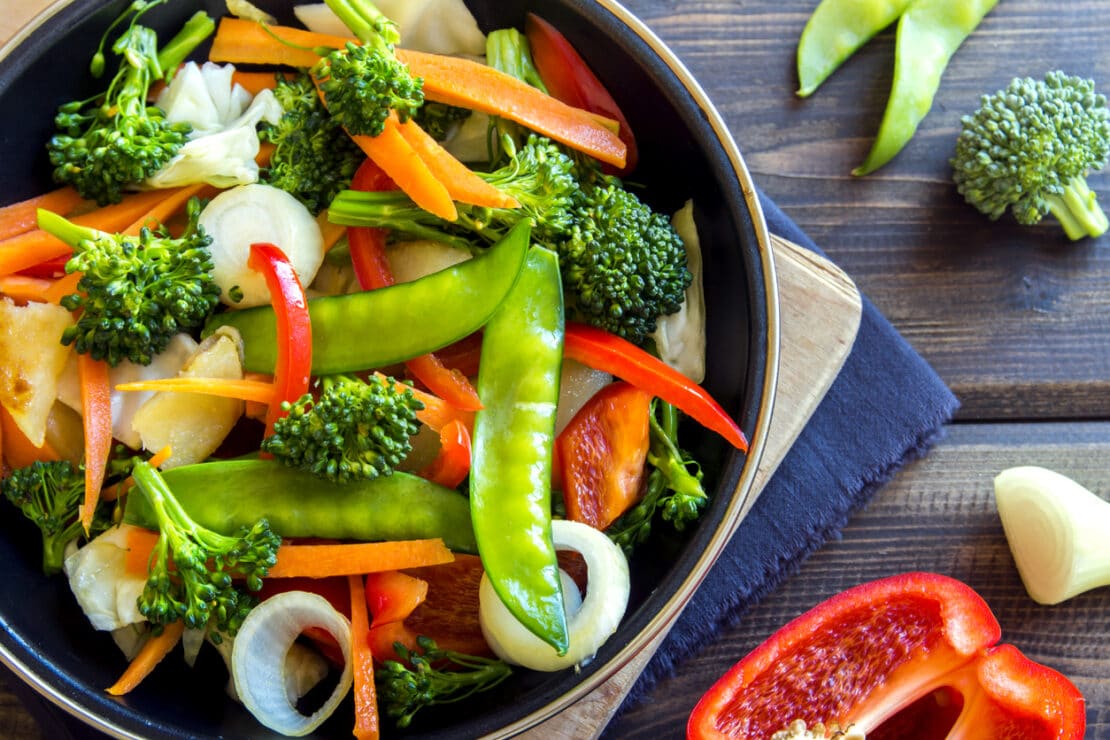The raw food diet has definitely generated a lot of hype in recent years. The idea behind it is that cooking reduces the nutritional value of many foods, especially vegetables.
But the fact is, cooked vegetables are not always nutritionally inferior.[1]
Many essential nutrients in vegetables are bound inside thick cellular walls. Cooking breaks down these walls and releases the nutrients. This increases their bioavailability. Cooking also softens cellulose fiber, which makes vegetables easier to digest. In some cases, heat may also reduce levels of harmful substances in foods.[2]
Here are seven veggies that are healthier cooked:
Asparagus
A study in the International Journal of Food Science & Technology found that cooking dramatically boosts levels of five antioxidants that help fight heart disease and cancer:[3]
- Quercetin, 98%
- Rutin, 32%
- Beta-carotene, 24%
- Lutein, 25%
- Zeaxanthin, 25%
Broccoli
Cooked broccoli contains higher levels of carotenoids than raw broccoli. The level is 32% higher in boiled broccoli and 19% higher in steamed.[4]
When cruciferous vegetables such as broccoli, cauliflower, and cabbage are cooked, it forms an organic compound called indole. According to research in The Journal of Nutrition, indole helps kill precancerous cells before they turn malignant.[5]
Carrots
Boiling carrots until tender increases the concentration of cancer-fighting carotenoids by 14%, according to a study published in the Journal of Agricultural Food Chemistry.
Boiling also boosts levels of the carotenoid lutein by 11%. Lutein plays an essential role in eye health and preventing diseases such as cataracts and macular degeneration.
Spinach
Raw or cooked, spinach is one of nature’s superfoods. But cooked spinach contains more absorbable calcium and iron. That’s because high temperatures break down oxalate. This is a compound in spinach that blocks the absorption of calcium and iron.
Quickly cooking spinach in boiling water, then placing it in cold water to halt cooking, reduces oxalate by 40%, according to one study.
Since about 75% of all kidney stones are composed primarily of calcium oxalate, high blood levels of oxalate are a major risk factor for this problem.[6]
Tomatoes
Cooking tomatoes releases high amounts of one of the world’s most powerful antioxidants: lycopene. It has been linked to lower rates of cancer and heart disease.
Lycopene is the red pigment that gives tomatoes their color. When tomatoes are cooked for 30 minutes, levels of absorbable lycopene go up by 35%. Antioxidant levels increase by 62%.
Among people who follow a strict raw food diet, low lycopene levels are common, according to a study published in The British Journal of Nutrition.[7]
Cooking does decrease vitamin C from tomatoes by up to 29%. But the trade-off may be worth it. Lycopene is considered a more powerful antioxidant.[8]
Mushrooms
Mushrooms are packed with antioxidants. And a study published in the journal Food Chemistry found that exposing mushrooms to heat drastically increases their antioxidant activity.[9]
Cooked mushrooms also have higher levels of bioavailable potassium, niacin, and zinc than raw ones, according to the USDA nutrition database.[10]
Kale
Raw kale is often an ingredient in smoothies. But cooking kale offers some nutrition advantages.
According the Harvard School of Public Health, raw kale contains isothiocyanates. They prevent the body from using iodine, which is vital for thyroid health.[11]
Cooking kale deactivates isothiocyanates. This stops the potential harm to your thyroid.[12]
One more thing…
Avoid frying vegetables.
Steam, boil, or microwave them. Carotenoids and other healthy compounds are often lost to the cooking oil or destroyed by the higher temperatures used in frying.
Editor’s Note: Discover natural, non-drug methods to transform your health. Read our monthly journal, Independent Healing. It’s your best source for unbiased, evidence-based medical information. For more information, click HERE.
Related Articles
Decoding the Little Stickers on Fruits and Vegetables
What’s the Best Time of Day to Take Your Vitamins?
5 Food Cravings That Can Signal a Nutrient Deficiency
References:
[1] http://pubs.acs.org/doi/full/10.1021/jf072304b
[2] https://www.consumerreports.org/fruits-vegetables/vegetables-that-are-healthier-cooked/?EXTKEY=I175E000&utm_medium=paid_social&utm_source=keywee&utm_campaign=Health&utm_content=vegetables-that-are-healthier-cooked&utm_keyword=desktop&kwp_0=553496&kwp_4=1989457&kwp_1=832708&loginMethod=auto
[3] http://onlinelibrary.wiley.com/doi/10.1111/j.1365-2621.2008.01871.x/abstract
[4] http://pubs.acs.org/doi/full/10.1021/jf072304b
[5] https://www.scientificamerican.com/article/raw-veggies-are-healthier/
[6] http://pubs.acs.org/doi/full/10.1021/jf048128d
[7] https://www.cambridge.org/core/journals/british-journal-of-nutrition/article/longterm-strict-raw-food-diet-is-associated-with-favourable-plasma-carotene-and-low-plasma-lycopene-concentrations-in-germans/AACB36B5CC49490A86FF154424FAEB82
[8] https://www.scientificamerican.com/article/raw-veggies-are-healthier/
[9] https://www.sciencedirect.com/science/article/abs/pii/S0308814605006540
[10] https://fdc.nal.usda.gov/ndb/
[11] https://www.hsph.harvard.edu/nutritionsource/food-features/kale/
[12] https://www.eatthis.com/vegetables-healthier-cooked/

